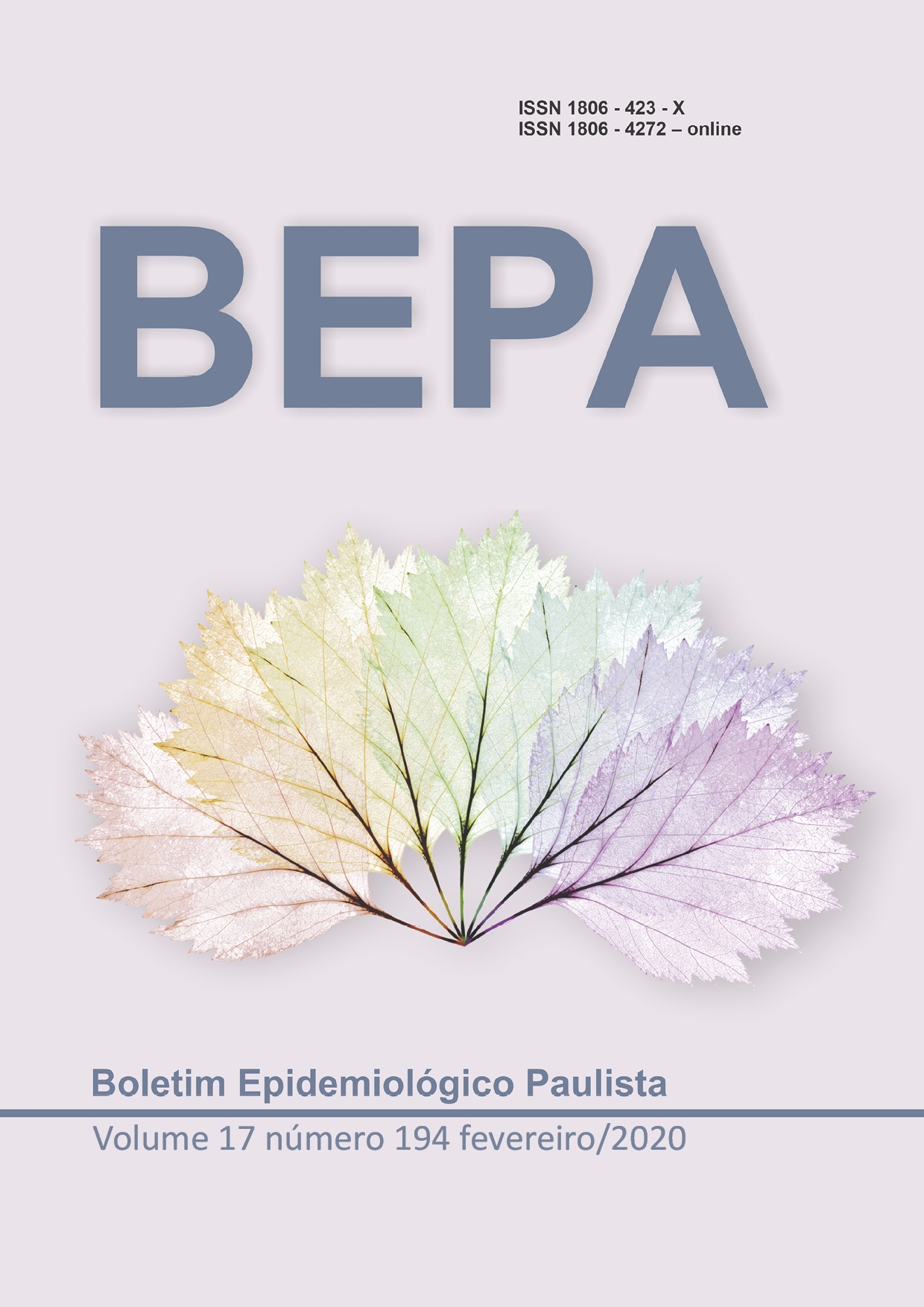Abstract
Objectives: To verify the evolution of cesarean in Vale do Paraíba from 2001 to 2015 and to analyze displacement of live births by cesarean and its
spatial distribution in the region (2013-2015). Methodology: Descriptive observational study based on microdata. The proportions of cesareans were compared and to analyze displacement, data from mothers residing in the Region were tabulated and the municipality of residence and occurrence. Results: The proportion of cesarean section increased from 50.1% in 2001 to 63.5% in 2015, however, there is a slight decrease in the last biennium (2014-2015). It was observed heterogeneous proportion of cesarean sections among the municipalities and almost all had increase in the three-year average. Of the live births by cesarean section in 2013-2015, 20.8% occurred in different municipalities from that of the mother’s residence. Displacement rates ranged from 2.4% to 100.0% and displacement occurred from municipalities with a smaller population to more populous. Discussion: Worldwide, Brazil is the leader in cesarean sections. The region has a higher proportion than Brazil’s and has shown increase in period of study. In order to reduce the displacement of mothers to other municipalities, the obstetric care network should offer childbirth care services in the mothers’ municipality of residence. Conclusions: The Region presents a heterogeneous distribution of the proportion of cesareans. Despite the increase in the period, there is a slight decrease in the last biennium. Displacement of live births by cesarean section occurs between the municipalities of the Region from smaller to more populous.
References
2. Lumbiganon P, Laopaiboon M, Gülmezoglu AM, Souza JP, Taneepanichskul S, Ruyan P, et al. Method of delivery and pregnancy outcomes in Asia: the WHO global survey on maternal and perinatal health 2007-08. Lancet. 2010;375(9713):490-9.
3. Souza JP, Gülmezoglu AM, Lumbiganon P, Laopaiboon M, Carroli G, Fawole B, and Ruyan P, the WHO Global Survey on Maternal and Perinatal Health Research Group. Caesarean section without medical indications is associated with an increased risk of adverse short-term maternal outcomes: the 2004-2008 WHO Global Survey on Maternal and Perinatal Health. BMC Med. 2010; 8:71.
4. Linton A, Peterson MR, Williams TV. Effects of Maternal Characteristics on Cesarean Delivery Rates among U.S. Department of Defense Healthcare Beneficiaries, 1996-2002. Birth. 2004; 31: 3-11.
5. Gibbons L, Belizan JM, Lauer JA, et al. Inequities in the use of cesarean section deliveries in the world. Am J Obstet Gynecol. 2012;206:331.e1-19.
6. Ronsmans C, Holtz S, Stanton C. Socioeconomic differentials in caesarean rates in developing countries: a retrospective analysis. Lancet. 2006; 368(9546): 1516-1523.
7. Betran AP, Torloni MR, Zhang J, Ye J, Mikolajczyk R, Deneux-Tharaux C et al. What is the optimal rate of caesarean section at population level? A systematic review of ecologic studies. Reprod Health. 2015;12(1):57.
8. Leal MC, Pereira APE, Domingues RMSM, Theme Filha MM, Dias MAB, Pereira MN, et al. Obstetric interventions during labor and childbirth in Brazilian low-risk women. Cad Saude Publica. 2014;30(1):S17-S47.
9. Hopkins K, Amaral EFL, Mourao ANM. The impact of payment source and hospital type on rising cesarean section rates in Brazil, 1998 to 2008. Birth. 2014;41(2):169-77.
10. Sass N, Mei Hwang S. Dados epidemiológicos, evidências e reflexões sobre a indicação de cesariana no Brasil. Diagn Tratamento. 2009; 14(4):7-33.
11. Oliveira RR, Melo EC, Falavina LP, Mathias TAF. The growing trend of moderate preterm births: an ecological study in one region of Brazil. PLoS
One 2015; 10(11):e0141852.
12. Nandi JK, Saha D, Mitra A, Pal S. Maternal morbidity in low risk nulliparous mother associated with cesarean delivery before labor and following induction labor. Int J Recent Sci Res. 2015;6(7):5501-4.
13. Seade. Região Metropolitana do Vale do Paraíba e Litoral Norte. 2016. Disponível em: <http://www.iprs.seade.gov.br/iprs2016/view/pdf/iprs/reg697.pdf>. Acesso em 22/11/2019.
14. Seade. Informações dos Municípios Paulistas. 2019. Disponível em: <http://www.imp.seade.gov.br/frontend/>. Acesso em 20/11/2019.
15. Emplasa. Região Metropolitana do Vale do Paraíba e Litoral Norte. 2019. Disponível em: <https://emplasa.sp.gov.br/RMVPLN>. Acesso em 19/11/2019.
16. Datasus. Sinasc. Disponível em: <http://datasus.saude.gov.br/informacoesde-saude/tabnet/estatisticas-vitais>. Acesso em 15/11/2019.
17. Brasil. Sinasc. Disponível em: <http://svs.aids.gov.br/dantps/cgiae/sinasc/apresentacao/>. Acesso em 02/11/2019.
18. Mello Jorge MHP, Laurenti R, Gotlieb SLD. Análise da qualidade das estatísticas vitais brasileiras: a experiência de implantação do SIM e do SINASC. Ciência & Saúde Coletiva. 2007; 12 (3):643-54.
19. Gibbons L, Bélizan JM, Lauer JA, Betrán AP, Merialdi M, Althabe F. (2010). The Global Numbers and Costs of Additionally Needed and Unnecessary Caesarean Sections Performed per Year: Overuse as a Barrier to Universal Coverage HEALTH SYSTEMS FINANCING. World Health Report 2010. 30.
20. Victora CG, Aquino EML, Leal MC, Monteiro CA, Barros FC, Szwarcwald CL. Maternal and child health in Brazil: progress and challenges. Lancet. 2011;377(9780):1863-1876.
21. Paris GF, Monteschio LVC, Oliveira RR, Latorre MRDO, Pelloso SM, Mathias TAFTendência temporal da via de parto de acordo com a fonte de financiamento. Rev Bras Ginecol Obstet. 2014; 36(12):548-54.
22. Brasil. Ministério da Saúde. Secretaria de Atenção à Saúde. Departamento de Regulação, Avaliação e Controle de Sistemas Critérios e Parâmetros
para o Planejamento e Programação de Ações e Serviços de Saúde no âmbito do Sistema Único de Saúde. Brasília, Ministério da Saúde, 2015.
23. Schramm JMA, Szwarcwald CL, Esteves MAP. Obstetrical inpatient care and hospitalization risks in hospitals of Brazil. Rev Saude Publica. 2002;36(5):590-7.
24. Rohr LK, Valongueiro S, Araujo TVBD. Delivery care and the inadequacy of the obstetric care network in Pernambuco. Rev Bras Saude Matern
Infant. 2016;16(4):447-55.
25. Korhonen J, Kariniemi V. Emergency cesarean section: the effect of delay on umbilical arterial gas balance and Apgar scores. Acta Obstet Gynecol
Scand. 1994;73(10):782-6.
26. Niyitegeka J, Nshimirimana G, Silverstein A, Odhiambo J, Lin Y, Nkurunziza T, et al. Longer travel time to district hospital worsens neonatal outcomes: a retrospective cross-sectional study of the effect of delays in receiving emergency cesarean section in Rwanda. BMC Pregnancy Childbirth. 2017;17:242.

This work is licensed under a Creative Commons Attribution 4.0 International License.
Copyright (c) 2020 Ana Beatriz Machado de Almeida, Zilda Pereira da Silva




